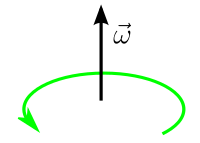Order of magnitude (angular velocity)

When you talk about order of magnitude in angular velocity, it is like explaining how fast something is spinning. This can be very tricky because there are different units that can be used to measure it, such as revolutions per minute (RPM), radians per second (rad/s), degrees per second (deg/s), or even cycles per second (Hz).
In order to make it easy to understand, let's use an example of a spinning wheel. Imagine that you are sitting on a playground and spinning a merry-go-round. The faster you spin it, the harder it is for you to hold on and the faster the world around you seems to go.
Now let's imagine that instead of spinning it with your hands, you have a motor that can make it spin. This motor can spin the wheel at different speeds, and we can use the different units of measurement to describe how fast it is spinning.
Let's say that the motor can spin the wheel at 1 RPM (one revolution per minute), which means the wheel will complete a full circle in one minute. If we convert this to radians per second, we get 0.1 rad/s. This means that the wheel is spinning at an angular velocity of 0.1 radians per second, which is a small order of magnitude.
If we increase the speed to 10 RPM, the wheel will complete ten full circles in one minute. Converting this to radians per second, we get 1.05 rad/s. This means that the wheel is spinning much faster than before, and we are now in a higher order of magnitude.
We can keep increasing the speed of the wheel, and the order of magnitude will keep getting higher. For example, if it spins at 100 RPM, the angular velocity will be 10.47 rad/s, which is even higher than before.
So, in summary, when we talk about order of magnitude in angular velocity, we are describing how fast something is spinning. The faster it spins, the higher the order of magnitude, and we can use different units of measurement to describe it.
In order to make it easy to understand, let's use an example of a spinning wheel. Imagine that you are sitting on a playground and spinning a merry-go-round. The faster you spin it, the harder it is for you to hold on and the faster the world around you seems to go.
Now let's imagine that instead of spinning it with your hands, you have a motor that can make it spin. This motor can spin the wheel at different speeds, and we can use the different units of measurement to describe how fast it is spinning.
Let's say that the motor can spin the wheel at 1 RPM (one revolution per minute), which means the wheel will complete a full circle in one minute. If we convert this to radians per second, we get 0.1 rad/s. This means that the wheel is spinning at an angular velocity of 0.1 radians per second, which is a small order of magnitude.
If we increase the speed to 10 RPM, the wheel will complete ten full circles in one minute. Converting this to radians per second, we get 1.05 rad/s. This means that the wheel is spinning much faster than before, and we are now in a higher order of magnitude.
We can keep increasing the speed of the wheel, and the order of magnitude will keep getting higher. For example, if it spins at 100 RPM, the angular velocity will be 10.47 rad/s, which is even higher than before.
So, in summary, when we talk about order of magnitude in angular velocity, we are describing how fast something is spinning. The faster it spins, the higher the order of magnitude, and we can use different units of measurement to describe it.
Related topics others have asked about:
